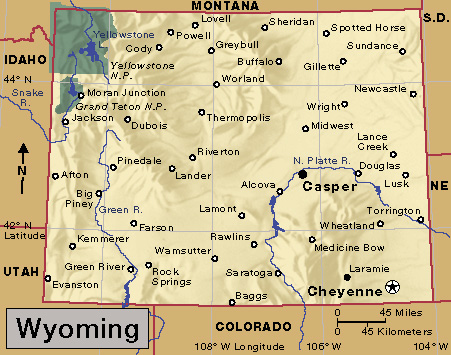Cheyenne << SHY ehn or shy AN >> (pop. 65,132; met. area pop. 100,512), one of the most historic towns of the Old West, is the capital and largest city of Wyoming. It serves as the trade center of a large agricultural area and as a major defense center of the United States. Cheyenne lies near the southeast corner of Wyoming.

Description.
Cheyenne is the county seat of Laramie County. The annual Cheyenne Frontier Days celebration, which began in 1897, is one of the nation’s most famous rodeos. The State Capitol, completed in 1888, also attracts many tourists. The Wyoming State Museum exhibits historical items of the Old West.

Just outside Cheyenne lies F. E. Warren Air Force Base, the site of the control center of one of the world’s largest intercontinental ballistic missile networks. The base is the headquarters of a missile unit that controls missiles spread across the surrounding region of Wyoming, Colorado, and Nebraska.
Federal, state, and local government entities employ many of Cheyenne’s people. Oil refining and cattle and sheep ranching also contribute to the economy of Cheyenne.
History.
Major General Grenville M. Dodge, the chief engineer of the Union Pacific Railroad, founded Cheyenne in 1867. He chose the site as a terminal for the railroad, which was being built westward from Omaha, Nebraska. Dodge named the city after the Cheyenne, an Indigenous (native) people who lived in the area.
Shortly after Dodge founded Cheyenne, thousands of people rushed there ahead of the railroad. Cheyenne became a boom town known for lawlessness. Outlaws controlled the town for a short time until vigilante groups restored order.
During the late 1860’s, cattlemen drove their animals north via trails from Texas to rangelands in Wyoming. Cheyenne served as a railroad shipping point and, by the early 1880’s, was the center of a large cattle-ranching area. The city became the territorial capital in 1869 and the state capital in 1890.
Fort D. A. Russell was built nearby at the same time as Cheyenne. It protected the railroad construction crews from being attacked by native peoples. In 1930, the post was renamed Fort Francis E. Warren in honor of Wyoming’s first governor. It became Warren Air Force Base in 1947. In 1963, the base became the headquarters of the 90th Strategic Missile Wing (now the 90th Missile Wing), control center of ballistic missile installations. Cheyenne has a mayor-council form of government.
